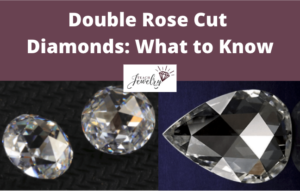
If you’re searching for a diamond to place as the main gem on an engagement ring or to complement another piece of jewelry, you’ve likely explored multiple cuts.
A double rose cut diamond is one of many options available, though it’s popularity doesn’t compare to classics like round, oval, or princess.
We’ll cover what to know about double rose cuts, including their history, pros and cons, how they differ from brilliant cuts, and tips for finding the right one.
What is a Double Rose Cut Diamond?
Double rose cut diamonds, also called double dutch cut diamonds, have a design that mimics a rose’s petals on the crown and pavilion.
It has a domed top and bottom that sometimes include horizontal facets.
Double rose cuts are a vintage-style diamond that looks similar to a briolette cut.
They’re a variation of the traditional rose cut diamond, which has a rounded top and flat bottom. The design is similar to taking two rose cut diamonds and attaching them together.
Here’s a comparison of a double rose cut and the traditional variation.
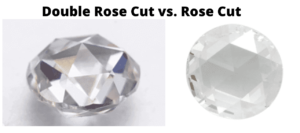
Notice how they appear similar from the top-down, but the bottom of the double rose cut has the same facet pattern as the top.
While rose cut diamonds have three to 24 facets, double rose cuts have more facets on the pavilion. This improves its sparkle, but it still produces a subtle glow instead of bright flashes of light.
History
Rose cut diamonds were developed as early as the 1500s. These antique cuts were handcrafted with wide, large facets meant to perform with lower amounts of light.
Specifically, they were placed under candlelight so the facets exhibited a soft glimmer.
The initial versions included only three to six facets, but diamond cutters knew they could improve its light performance if more were added.
This led to the creation of six- and 12-facet rose cuts. Designers continued adding more facets until eventually the double rose cut and its two layers of facets were created.
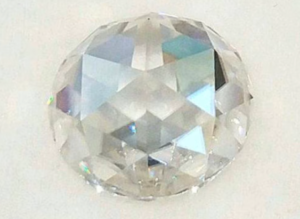
Often worn during the Georgian and Victorian eras, rose cuts, and eventually double rose cuts, were surpassed in popularity by brilliant cut diamonds in the early 20th century.
Pros
Price-Per-Carat
Double rose cut diamonds cost less per carat than most other cuts for two reasons.
First, there is lower demand compared to brilliant and step-cut diamonds, which lowers the price. Brilliance is one of the most valued traits in a diamond, so most buyers opt for a brilliant diamond versus a rose cut.
The high demand for round brilliants, princess, and cushion cuts allow retailers to raise the price.
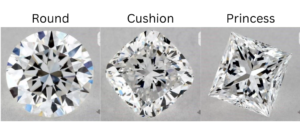
Additionally, some other cuts waste more of the original rough diamond.
When a significant portion of the diamond has to be discarded to create the shape of a round brilliant, the manufacturer has to compensate by raising the price compared to double rose cuts.
Multiple Shapes
Double rose cut diamonds are available in multiple shapes.
The traditional style is rounded, with an identical dome on the crown and pavilion, but they can be formed into many of the same shapes as brilliant cuts.
For example, its usual circular shape can stretch into an oval or have a pointed end as a pear cut.
Here’s the pear cut variation.
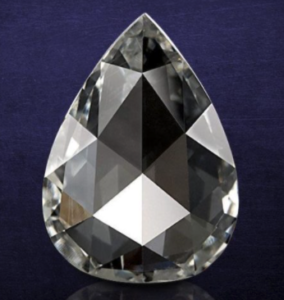
The facets are large and easy to identify in that close-up view.
The key is double Dutch cuts still have the two layers of facets. If you flip the diamond over, it’s identical on the other side.
This is in contrast to a single layer on top and a flat bottom on a standard rose cut.
The shape you choose won’t only impact its visible appearance. It also plays a role in light performance. If you opt for a fancy shape versus round, it likely won’t return as much light.
Fit for Colored Diamonds
Most buyers want a colorless diamond, which is why they’re the most valuable and earn the highest grades from the Gemological Institute of America (GIA).
Shades of yellow or brown cause a diamond to earn a lower color grade, and it diminishes its appearance and light performance.
Here are some examples of the colors available for double rose cut diamonds.
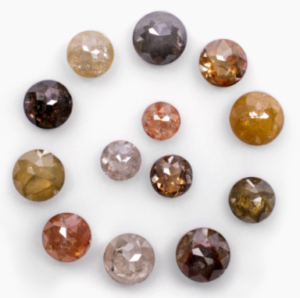
So if there’s an instance in which you want a colored diamond, consider yellow, green, blue, or red double rose cuts.
They don’t exhibit much brilliance and aren’t often used on engagement rings, but they’re a unique element to some pieces of jewelry. You might decide to place it as the main gem in a necklace or line a bracelet with multiple colors.
Colorless double rose cut diamonds don’t hide color as well as other cuts, so it accentuates these warmer colors.
If you’re considering a champagne diamond or one with a shade of orange, you may decide a double rose cut is the best fit.
Appears Larger Than Some Cuts
A diamond’s size isn’t measured by its visible appearance. Instead, it’s measured by weight.
One carat equals 0.2 grams. So a one-carat diamond, compared to 0.9, is bigger, even if they look the same size to the naked eye.
But many buyers are concerned with how large it appears to the naked eye. The shape of some facets showcase its size more than others, and double rose cuts are toward the top of the list.
It has a large circumference compared to other cuts.
For example, a one-carat round brilliant cut often measures 6.5 millimeters when viewed from the top-down. Double rose cuts can measure up to 7.5 millimeters.
It doesn’t hide as much weight under the surface. Its surface area is more elongated.
To illustrate, here’s an image of several double rose cuts.
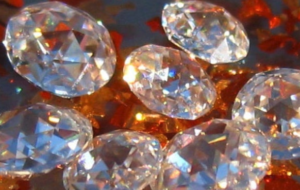
Notice they’re wide surface areas and how they don’t come to as sharp a point as round cuts.
With a larger visible appearance and low cost-per-carat, double rose cut diamonds allow you to select a heavier diamond with the same budget.
Uniqueness
While some buyers don’t want to deviate from traditional cuts like round brilliants, the uniqueness of double rose cuts are appealing to others.
It’s likely you’ve never had a friend show off their new engagement ring that’s fit with this style. Instead, buyers tend to choose ones with stronger light performance.
But if you aren’t concerned about the way it glimmers when it twirls, and you’re content with a soft glow, you could have a diamond ring that stands out among others.
My only recommendation is to consider avoiding a solitaire setting with a double rose cut. Without other diamonds on the piece, it won’t have the sparkle most buyers expect from their engagement ring.
Cons
Lacks Brilliance and Fire
Double rose cuts lack the brilliance and fire seen in other cuts.
Brilliance refers to the white light that radiates from a diamond. Light enters the diamond and is reflected back toward the viewer.
Fire is the rainbow of colors that flash from a diamond. Known as light dispersion, light is refracted inside the diamond and speeds up as it exits.
Check out the image below of colored light reflecting from the diamond.
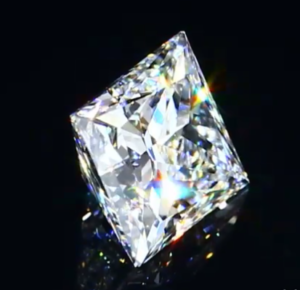
In a way, the diamond is a prism that bends and refracts light at different rates.
This causes colors such as green, yellow, orange, and blue to disperse from the diamond.
The facets on double rose cuts aren’t designed to maximize light performance. It’s why they aren’t a popular choice for engagement rings.
Brilliant cuts have kite-shaped facets and a pointed culet at the bottom. These features combine to allow light to bounce through the diamond and back to the viewer.
I’ve highlighted both in the image of a round-cut diamond below.
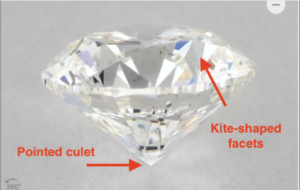
The culet on a rose cut diamond isn’t designed to produce this effect.
Additionally, brilliant cuts have far more facets to reflect light than double rose cuts.
Fewer Options Available
There are fewer options available on the market for double rose cut diamonds compared to brilliant and step-cuts. In fact, you won’t find them sold as loose diamonds at popular retailers.
Some industry estimates indicate one out of one thousand diamonds on the market are rose cuts, so even fewer are double rose cuts.
They’re difficult to find as the center stone for an engagement ring, but some retailers offer them as accents surrounding the main gem.
For example, this emerald and rose cut diamond flower ring features a round emerald encircled by rose cuts.
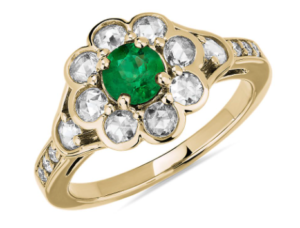
Neither the center gem nor the rose cuts will produce much brilliance, but the whole piece will have a soft glow. There are three round cuts lining each side, so you’ll have three types of stones on the ring.
This design includes a sapphire in the middle with a halo of rose cuts around it.
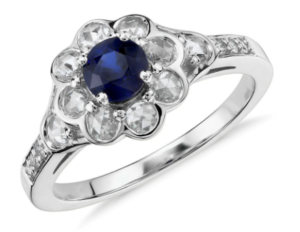
In both instances, you can’t see the pavilion of the rose cut, so even if it were a double rose cut, it appears the same as a traditional one.
Rose and double cuts are often placed in necklaces, where there’s less of an emphasis on brilliance.
Instead of selling loose double rose cut diamonds, retailers will often have already placed them in a piece of jewelry.
The result is fewer customizations.
Doesn’t Hide Inclusions
Inclusions are the white, black, and transparent flaws in a diamond. Some are visible to the naked eye, but they all impact light performance and durability.
For example, I’ve pointed out some of the clarity characteristics on this diamond.
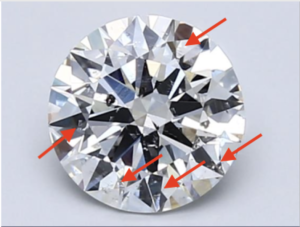
The GIA report shows the following are present:
- Twinning wisps
- Crystals
- Clouds
- Feathers
- Needles
- Indented naturals
The extent to which they affect durability, brilliance, and overall appeal depends on their size, type, and location.
While brilliant cut diamonds can hide some inclusions with the scintillation that radiates from its facets, inclusions are often more visible in double rose cut diamonds.
There isn’t white or colored light flashing off its surface to hide blemishes.
Too many inclusions results in a salt and pepper diamond. Check out these double rose cuts, which have significant inclusions.
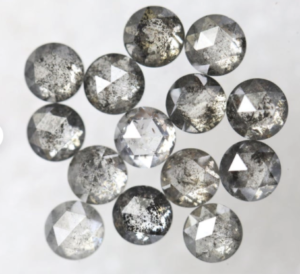
You wouldn’t want to include these on a piece of jewelry.
Inclusions are often invisible to the naked eye for diamonds given a clarity grade of SI1 or above from the GIA, but if you want an eye-clean double rose cut, consider VS2 or above.
While the GIA report provides information about its imperfections, the only way to know if it’s eye-clean is to view the diamond in person. High-resolution images online are also helpful.
If the cut is used as an accent, jewelers often use SI2 diamonds. Because they’re so small, even ones with significant blemishes appear clean without magnification.
Shades of Yellow
Unless you’re intentionally choosing a colored double rose cut, you’ll have to select one with a higher color grade to avoid shades of yellow.
No matter the cut, colorless diamonds are the most valuable because of their visual appeal and rarity. Most diamonds have tints of yellow or brown, and the extent of their color impacts their placement on the GIA color scale.
Colorless diamonds earn a D grade, and they move down the scale toward Z as more yellow and brown are visible.
To demonstrate the importance of avoiding shades of yellow, here’s a side-by-side comparison of a D versus J color grade.
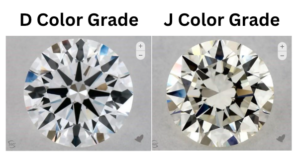
Because double rose cuts don’t have brilliant-cut facets, they don’t disguise yellow in the same way as round, marquise, or princess cuts.
With those brilliant cuts, most that earn grades I or above appear colorless. Their shades of yellow are only visible with magnification.
For double rose cuts, I recommend starting your search at an H color grade and working your way up the scale until you find one that appears colorless.

You’ll save on cost compared to a truly colorless diamond, but it’ll look identical to one with a D grade.
The exception is for small gems used as accents. In those cases, an I color grade often means the yellow isn’t noticeable.
Is a Double Rose Cut Right for You?
Double rose cut diamonds aren’t a common diamond cut, but it could be the right style for you.
Whether placed around a brilliant cut, sapphire, ruby, or emerald, it can serve as a complement to another gem or stand alone in a ring or other jewelry.
A double rose cut may be right for you if:
- The traditional rose cut is appealing, but you want more facets
- The subtle glow of a double rose cut is preferable compared to the strong brilliance of other diamonds
- You’re looking for a way to support another gem on a ring without detracting from it
- You want a diamond that appears larger than other cuts and costs less per carat
- To avoid shades of yellow and visible inclusions, you’re willing to choose at least an SI1 clarity and H color
By examining many double rose cuts and understanding what makes them unique, you’ll find the right diamond for any piece of jewelry.

Jacob Clarke
Jacob Clarke is the founder of TeachJewelry.com.
He earned an Applied Jewelry Professional Diploma from the Gemological Institute of America (GIA) and now brings you essential information about diamonds, settings, and more.
Jacob has consulted with leading jewelry brands, and his work has been cited in Clean Origin, Diamond Nexus and industry publications.
He's also a member of the International Gem Society.
He enjoys discussing jewelry with readers, so contact him with any questions at jacob.clarke@teachjewelry.com.













